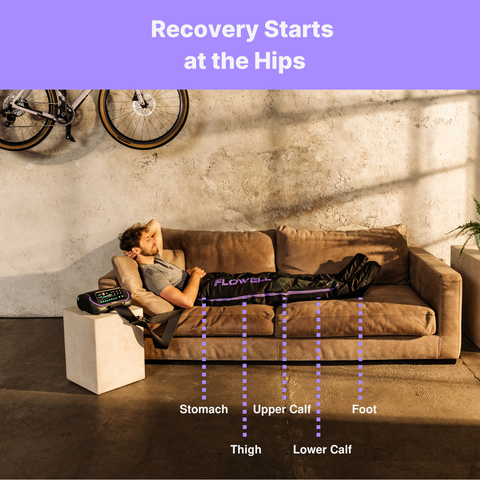When it comes to movement, the body doesn’t lie — it all starts at the hips. Walking, running, squatting, rotating — everything we do relies on the mobility and strength of our hips. And yet, most recovery systems on the market stop short, treating only from the foot to the knee. At Flowell, we believe that recovery should be just as complete as your movement. That’s why we go further — literally.
The Power of the Kinetic Chain
Your body is a kinetic chain — meaning that every joint and muscle works in a coordinated sequence. This is especially true when it comes to the lower body. According to the widely accepted mobility-stability continuum, the ankle needs mobility, the knee requires stability, and the hip needs mobility again. When hip mobility is compromised, it throws off this balance — resulting in tightness, pain, and overcompensation in the knees and lower back.
In fact, poor hip mobility is a leading cause of both knee injuries and chronic back discomfort. It limits range of motion, reduces circulation, and puts unnecessary stress on stabilizing joints. That’s why improving hip mobility is not just a “nice to have” — it’s essential to injury prevention and performance.
What Most Recovery Systems Miss
If you’ve used compression therapy before, you’ve probably experienced boots that cover the foot, calf, and maybe the lower thigh. But here’s the issue: those systems only treat 60–70% of the leg. The most critical region — the glutes and hips — is left untouched.
And here’s a simple question we always ask:
When was the last time you used your knee without engaging your hip?
You can’t. The two are connected. So if you're only treating one, you're short-changing your recovery.
Flowell: Recovery That Reaches the Source
Flowell is different. Our compression system is designed with full-leg coverage in mind — all the way from foot to hip. That means we’re actively supporting blood circulation, lymphatic drainage, and hydration of the fascia and muscles where it matters most.
By restoring mobility at the hip, Flowell protects the knees and spine — and delivers better outcomes in the same amount of time. Whether you’re a physical therapist, gym owner, or health-conscious individual dealing with chronic swelling, this extra coverage can mean the difference between partial relief and total recovery.
More Coverage. Better Results. Same Time.
For professionals offering recovery sessions, Flowell makes the upsell easy:
-
30% more coverage
-
Greater client satisfaction
-
Scientifically-backed therapy that fits real life
And for the individual: it’s time to stop accepting half solutions. Your recovery deserves to be as complete as your workout.
Ready to see the difference?
Check out www.flowell.com and step up your recovery game!




